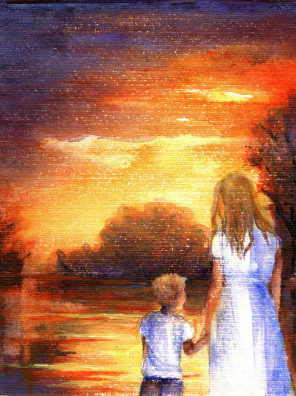
nex discovery RAINWATER IS FORMED BY CHEMICAL REACTION ITSELF IN THE ATMOSPHERE
8 pagesPHOTOLYSIS (PHOTODEGRADATION OR PHOTODISSOCIATION) OCEAN WATERS
this is the decomposition of the water molecule into hydrogen molecule (H2) and oxygen atom (O) under the effect of solar radiation, namely Ultraviolets, X and gamma are usually involved in such reactions.
In other words this is the decomposition of a body by the light (H2 = 2/29 = 0.06) and (O = 16/29 = 0.55), both lighter-than-air (29 / 29 = 1), they are driven by the currents of hot and dry air
SYNTHESIS OF WATER IN THE ATMOSPHERE (RAIN)
The hot air with H2 and O enters high in the cold air and forms a kind of balloon, cold air and pushes the covers from all sides, it compresses and at favorable rates triggers combination of the two gases in a real explosive chemical reaction H2+O---> H2O











Ce livre est noté par
HELLO
FLASH + THUNDER + WATER (RAIN) = one operation,how ?
http://pdf.lu/hO6q (in one page)
1-Photolysis (dissociation or photolysis) of ocean water consists of the decomposition of the water molecule into hydrogen molecules (H2) and carbon (O) under the effect of solar radiation in the ultraviolet.
https://fr.wikipedia.org/wiki/Photolyse www.google.dz/search?q=photolyse
Due to the depletion of the ozone layer in certain regions of the globe, sunlight reaches the surface of the earth and enriched with UV-C radiation (λ = 100 -280 nm) to shorter wavelength (Lloyd, 1993), between 11 and 16 pm their luminous intensity is still significant and more to 14 h, these UV through a smaller distance in the atmosphere and are not intercepted by the ozone molecules, they are able to the surface of the earth and the water molecules dissociate into H2 and O free, the rate is higher in the mountains, and are reverberated through water and snow.
http://biologiedelapeau.fr/spip.php?mot162
2- The molecules (H2) and atoms (O) are driven by the currents of warm air upward, dry representing a mechanical force that opposes that of cold air downdrafts, there is opposition two mechanical forces of compression where the volume of air including a mixture of oxygen (O) and hydrogen (H2) which both agitated by the fact that the compression, friction and the effect of solar radiation (ionization ) are charged with positive electricity and negative for hydrogen for oxygen and a favorable compression ratio, the two gases combine in an explosive chemical reaction (synthesis of water is explosive), they form the water (rain).
H2 --> 2H⁺ + 2 é-
½ O2 + (2H⁺) + 2é- --> explosion – Flash-Thunder -Rain (H2O + heat)
3- The light of the lightning reaches us first (299,792,458 m / s), the sound of the explosion was thunder (340 m / s) in the second and finally the raindrops whose fall speed is lower to those of the light and sound.
So: Flash + Thunder + water = one operation
Nitrogen is known by its inertia to respond, the synthesis of water is exothermic, it will form ammonia in a reversible reaction
N2+3H2 -->2NH3
N2+3H2<-- 2NH3, and nitrogen oxides.H2 molecules were free to combine with oxygen atoms by the same method.
4- How to form a cloud?
These are the first explosive reactions of synthesis of water that are responsible for the birth of a cloud, and as they are exothermic, cold air that surrounds it even contracts (compression), the remaining amounts hydrogen and oxygen react in turn within the cloud to further form water, there is shown out of the lightning from the cloud, each storm cell can cause more than 100 flashes per minute http://www.astrosurf.com/luxorion/meteo-orages3-eclairs.htm.
Until exhaustion of hydrogen, leaving only water suspended in the cloud whose molecules coalesce and form a steady rain without lightning. Thunder is in fact only the sound of the noise of the explosions. So we understand that "lightning + thunder + rain = one operation" and then "condensation-->rain".
It occurs 24 hours around the Earth between 2000-5000 storms per second http://www.planetoscope.com/atmosphere/252-nombre-d-orages-dans-le-monde.html that is to say it forms water in the atmosphere from 172,800,000 to 432,000,000 times between the atmosphere by then coalesced synthesis but the original source of his training remains
BONJOUR,
A ce jour, le monde scientifique demeure endoctriné par cette théorie évasive (évaporation, formation nuage-condensation -pluie)
A partir de la question suivante:
Les molécules d’eau se détachent-elles de leur ensemble sous l’effet de la chaleur en tant que telles c'est-à-dire en tant que corps composés H2O pour former la vapeur d’eau qui se condensera en hauteur et formera la pluie ?
OU Sont-elles carrément décomposées par photolyse en H2 et O en tant que corps gazeux simples qui se combineront à la suite d’une véritable réaction chimique explosive (synthèse de l’eau en atmosphère) ?
En traitant les mêmes données scientifiques universelles admises à ce jour , voilà à quoi on aboutit (éclair+tonnerre+pluie= une seule opération) plus convaincante et plus claire. Je dis comment naît le nuage lui même en réalité
http://pdf.lu/hO6q (dans une page)
http://pdf.lu/x1HD (pour plus de détails 4 hypothèses dont 3 nouvelles -2016-)
Synthèse de l'eau en atmosphère: éclair+tonnerre+pluie --> une seule opération
1-La photolyse (photodissociation ou photo-décomposition) des eaux océaniques consiste en la décomposition de la molécule d’eau en molécules d’hydrogène (H2) et en atomes (O) sous l’effet de rayonnements solaires, en l’occurrence les ultraviolets.
https://fr.wikipedia.org/wiki/Photolyse www.google.dz/search?q=photolyse
2-Les molécules (H2) et les atomes (O) sont donc entraînés par les courants ascendants d'air chaud et sec qui représentent une force mécanique à laquelle s’oppose celle des courants descendants d’air froid, on assiste à l’opposition de deux forces mécaniques d’où compression du volume d'air englobant un mélange d’oxygène (O) et d’hydrogène (H2) qui tous deux agités par le fait de la compression , les frottements et l’effet des rayons solaires (ionisation) se chargent d’électricité positive pour l’hydrogène et négative pour l’oxygène et à un taux de compression favorable, les 2 gaz se combinent dans une réaction chimique explosive (la synthèse de l'eau est explosive), ils forment de l’eau (pluie) :
Donc : éclair+tonnerre+eau = une seule opération
3-L’azote est connu par son inertie à réagir, la synthèse de l’eau est exothermique, il formera de l’ammoniac dans une réaction réversible
N2+3H2 -->2NH3
N2+3H2 <--2NH3 ainsi les molécules H2 étant libres se combinent à leur tour aux atomes d’oxygène selon le même procédé.
4-Comment se forme un nuage ?
Ce sont les premières réactions explosives de synthèse de l’eau qui sont à l’origine de la naissance d’un nuage et comme elles sont exothermiques, l’air froid qui l’entoure le contracte encore (compression), les quantités restantes d’hydrogène et d’oxygène réagissent à leur tour à l’intérieur de ce nuage pour former encore de l’eau, on y voit sortir des éclairs à partir du nuage, chaque cellule orageuse peut provoquer plus de 100 éclairs par minute, http://www.astrosurf.com/luxorion/meteo-orages3-eclairs.htm, jusqu’à épuisement de l’hydrogène, il ne reste que de l’eau en suspension dans le nuage dont les molécules s’unissent par coalescence et forme une pluie régulière sans éclair. Le tonnerre n’est en fait que le son du bruit de ces explosions. On comprendra donc que « éclair+tonnerre+pluie = une seule opération » et ensuite « condensation-->pluie ». Il se produit en 24 heures autour de l a terre entre 2000 à 5000 orages par seconde http://www.planetoscope.com/atmosphere/252-nombre-d-orages-dans-le-monde... c'est-à-dire qu’il se forme de l’eau dans l’atmosphère entre 172.800.000 à 432.000.000 fois dans l’atmosphère par synthèse ensuite par coalescence mais l’origine initiale de sa formation reste une véritable réaction chimique. Ainsi on sait comment toute cette eau s'est formée sur terre: toute la quantité (2volumes) d'hydrogène s'est combiné à (1volume d'oxygène) dans des réactions explosives similaires à celles qui se produisent au dessus des volcans (la terre était une boule de feu), le volume d'oxygène restant forma la couche d'ozone, les 21% de dioxyde de l'air, l'azote est connu pour son inertie à réagir, c'est ce qui explique son abondance (78% de l'air).